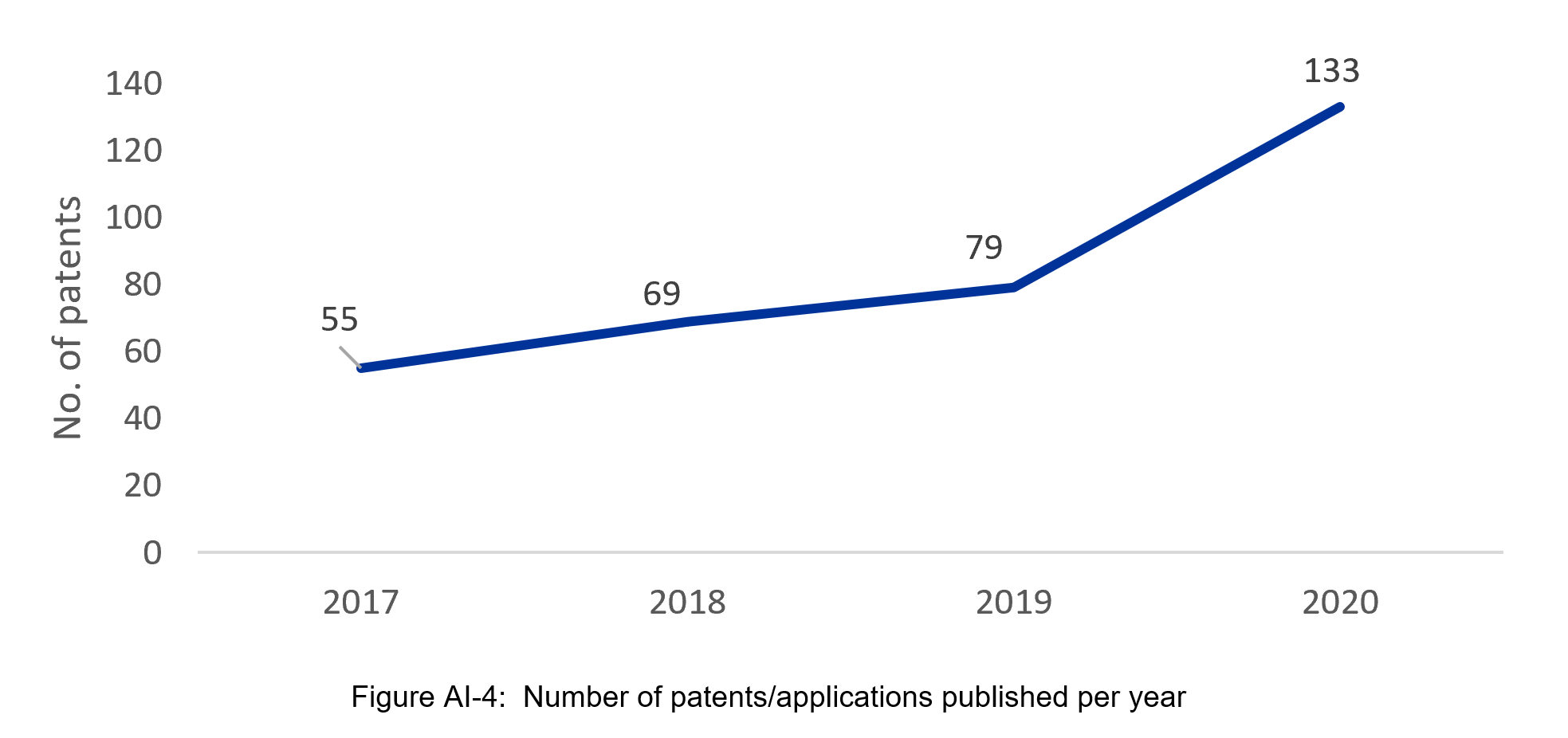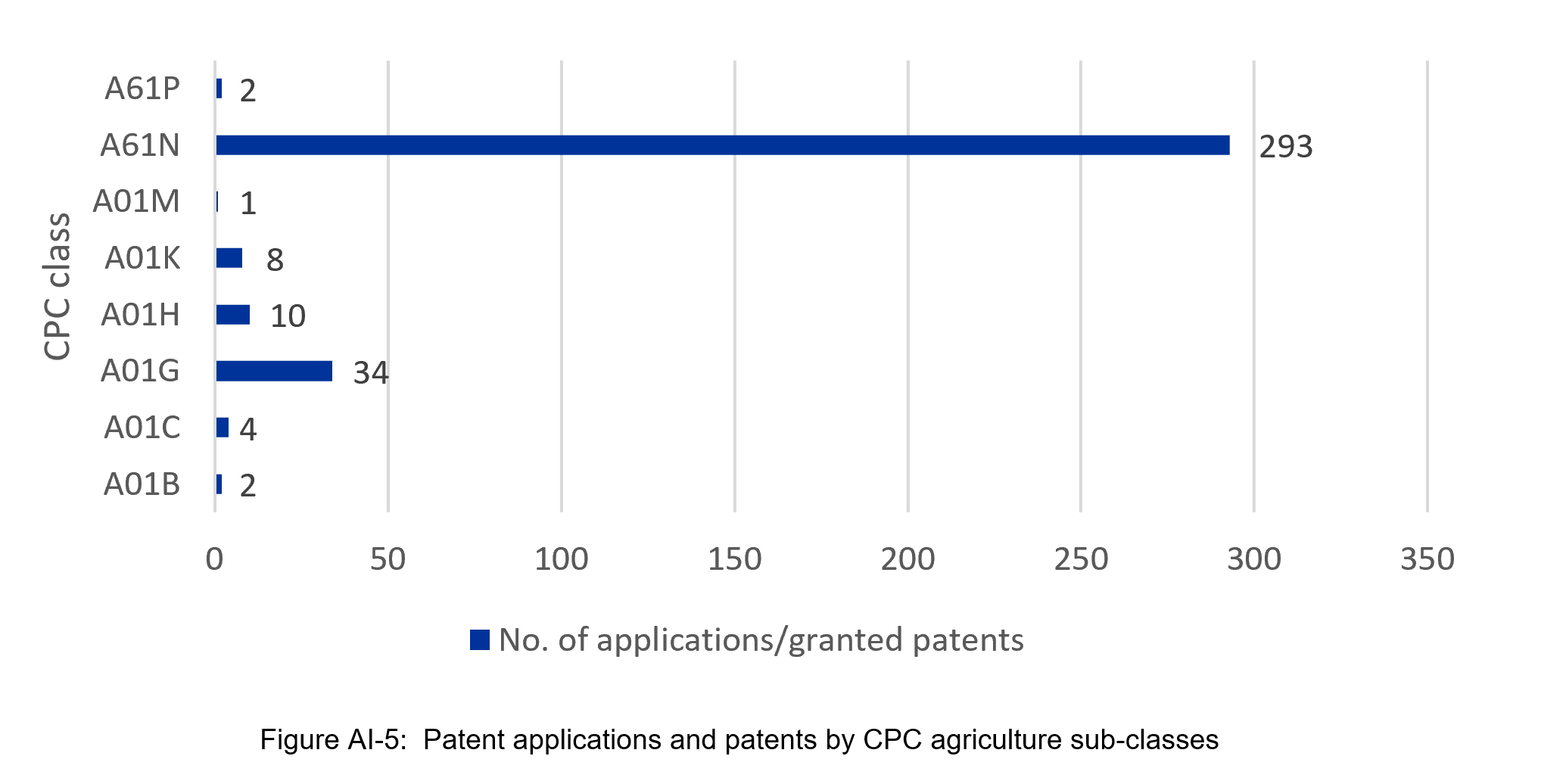Patents - EUON
Agriculture
Overview
This section looks at the patenting activity in the field of nanotechnology and agriculture from 2017-2020. Granted patents and patent applications focused on agriculture and nanotechnology were extracted from the general collection of nanotechnology patents between 2017-2020 developed by the study team for the database. The patents were collected from Espacenet database maintained by the European Patent Office.
The dataset of patents on agriculture and nanotechnology was developed by extracting the granted patents and patent applications that contained the CPC classes and sub-classes dedicated to agriculture in their bibliographic information. It should be noted that most nanotechnology patents contain multiple classes in their subject descriptions. In CPC agriculture is covered under A01 class.
| Table AI-2: Agriculture in the Cooperative Patent Classification (CPC)1 | |
|---|---|
| Class | Title |
| A01B | Soil working in agriculture or forestry; parts, details, or accessories of agricultural machines or implements, in general |
| A01C | Planting; sowing; fertilising |
| A01D | Harvesting; mowing |
| A01F | Processing of harvested produce; hay or straw presses; devices for storing agricultural or horticultural produce |
| A01G | Horticulture; cultivation of vegetables, flowers, rice, fruit, vines, hops or seaweed; forestry; watering |
| A01H | New plants or {non-transgenic} processes for obtaining them; plant reproduction by tissue culture techniques |
| A01J | Manufacture of dairy products |
| A01K | Animal husbandry; care of birds, fishes, insects; fishing; rearing or breeding animals, not otherwise provided for; new breeds of animals |
| A01L | Shoeing of animals |
| A01M | Catching, trapping or scaring of animals; apparatus for the destruction of noxious animals or noxious plants |
| A01N | Preservation of bodies of humans or animals or plants or parts thereof; biocides, e.g. as disinfectants, as pesticides or as herbicides; pest repellants or attractants; plant growth regulators |
| A01P | Biocidal, pest repellant, pest attractant or plant growth regulatory activity of chemical compounds or preparations |
Patents on nanotechnology in agriculture
As a result of patent collection mining, 336 patent applications and granted patents published from 2017-2020 were identified. The number of patents and patent applications containing agriculture classifications steadily increased each year.

Most patents (274, 82%) were published in the national patent offices, while the rest were published in the World Intellectual Property Organisation (WIPO, 57, 17%) and the European Patent Office (5, 2%).
China (206 applications, 61%) prevailed amongst all countries with the most patent applications published. Other countries, such as the USA, Russian Federation, South Korea and Australia, were in top five by the number of published applications, but significantly lagged behind China.
| Table AI-3: Top-five countries by filed patents/applications in agriculture and nanotechnology in 2017-2020 | |
|---|---|
| Country | No. of patents/patent applications, % |
| China | 206, 61% |
| USA | 26, 8% |
| Russian Federation | 9, 3% |
| South Korea | 9, 3% |
| Australia | 9, 3% |
Patent applications and granted patents contained twelve CPC sub-classes referring to agriculture. One patent application might combine several agriculture-related CPC sub-classes. The overwhelming majority of patents and applications focused on applications of nanotechnology in preservation of bodies of humans or animals or plants (i.e., biocides, pesticides or herbicides) (A01N, 293 applications and patents, 86%).

Patents dedicated to other fields were much less visible. Only 34 (10%) patents/applications focused on A01G (horticulture; cultivation of vegetables, flowers, rice, fruit, vines, hops, or seaweed; forestry; watering), 10 (3%) on A01H (new plants or non-transgenic processes for obtaining them; plant reproduction by tissue culture techniques) and 8 (2%) on A01K (animal husbandry; care of birds, fishes, insects; fishing; rearing or breeding animals, not otherwise provided for; new breeds of animals).
| Table AI-4: Examples of patents focused on A01N sub-class | |
|---|---|
| Bibliographic information | Abstract |
| Zhao, H. et al. (2017). Method of Growing the Plants With Using Metal Nanoparticles and Substratum for Its Implementation. Patent no. RU2612319C1. Available here. (Granted patent) |
In the process of growing a plant by using nanoparticles germination and subsequent growth of plants under aseptic conditions on an agar medium containing the nanoparticles. The agar nutrient medium is used, which contains iron nanoparticles, zinc nanoparticles or copper nanoparticles, or a combination of iron, zinc, and copper nanoparticles. Agar nutrient medium contains necessary for plant development components included in the culture medium of Murashige-Skoog medium, namely organic substances, including vitamins, carbohydrates and amino acids and/or protein hydrolysates, as well as a chelating agent, inorganic salts containing nitrogen, phosphorus, sodium, potassium, calcium, magnesium, sulfur, chlorine, iodine, boron, manganese, molybdenum and cobalt as well as iron, zinc and copper. Thus iron or zinc, or copper, or iron, zinc, and copper in the combination belong to the culture medium in the form of metal nanoparticles.EFFECT: invention can improve seed germination, plant morphometric and physiological indicators.10 cl, 21 dwg, 1 tbl, 3 ex |
| Xu, X. (2020). Antimicrobial Substrate Surface. Available here. (Granted patent) | Structure (1) comprising an antimicrobial surface (2) on a substrate (3), the antimicrobial surface comprising a plurality of nanostructures (4), each nanostructure (4) comprising: i. a nanopillar (5) on the substrate, the nanopillar (5) having a height (H), and ii. a head (6) covering a distal end (7) and at least part of the height (H) of the nanopillar (5). |
Agriculture innovation breakthroughs in patents
Innovation breakthrough is a particular type of innovation that has a profound effect on subsequent inventions, products and services. Three indicators of patents were studied to identify innovation breakthroughs – number of forward citations, number of citing organisations and number of citing countries. The study did not identify innovation breakthroughs in agriculture patents between 2017-2020.
1 European Patent Office. (2022). Cooperative Patent Classification, A: Human necessities agriculture. Available at: https://www.cooperativepatentclassification.org/sites/default/files/cpc/scheme/A/scheme-A.pdf


